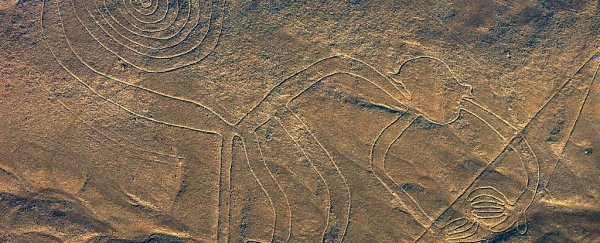The 2,000 year old Nazca Lines are the world's best known example of geoglyphs – and they're beautiful. Huge symbols of monkeys, fish, and other animals up to hundreds of metres long - preserved for so long we don't know what they were there for.
But one area was badly damaged on Saturday when a truck driver ran them over.
Jainer Jesus Flores Vigo was detained after allegedly ignoring warning signage and driving over the heritage listed site.
#COMUNICADO: Ministerio de Cultura denuncia penalmente a chofer de camión que ingresó a la Pampa de Nasca: https://t.co/SlcJeyYgMm #PrensaCultura pic.twitter.com/rdMf26Eo8r
— Ministerio de Cultura (@MinCulturaPe) January 29, 2018
According to CNN, authorities found deep tire marks across an area of 50 by 100 metres (164 by 328 feet) in the site's grounds and damage to three geoglyphs.
Peruvian newspaper Peru21 says that Peru's Public Ministry had sought nine months of preventive detention and a fine of 5,000 Peruvian soles, or about US$1,550. But a judge on Tuesday concluded there wasn't enough evidence to indicate the driver acted with intent. So he has been released without penalty.
Geoglyphs – like the ones in the Nazca Desert in southern Peru – are known for being structures best seen from above, like a high vantage point or a plane.

The Nazca Lines, created by the Nazca people between 500 BCE to 500 CE, are an incredible sight to behold.
There are hundreds of simple lines and geometric shapes, but over 70 are designs of animals, including birds, llamas, trees, jaguars, and even human figures.
"They are the most outstanding group of geoglyphs anywhere in the world and are unmatched in its extent, magnitude, quantity, size, diversity and ancient tradition to any similar work in the world," UNESCO said.
But the way they are formed has also made them easy to disturb. They are made with shallow lines (10 - 30 centimetres or 4-12 inches deep) in the ground by removing reddish pebbles, and uncovering the grey ground underneath.
Basically, they'd be no match for a truck.
But it's not just trucks that have damaged the incredible art in recent years. Greenpeace was in hot water in 2014 for trampling over the site to lay down large cloth letters near a symbol of a hummingbird.
These geoglyphs have managed to stick around for 2,000 years. Let's hope our stupidity doesn't ruin them for generations to come.
